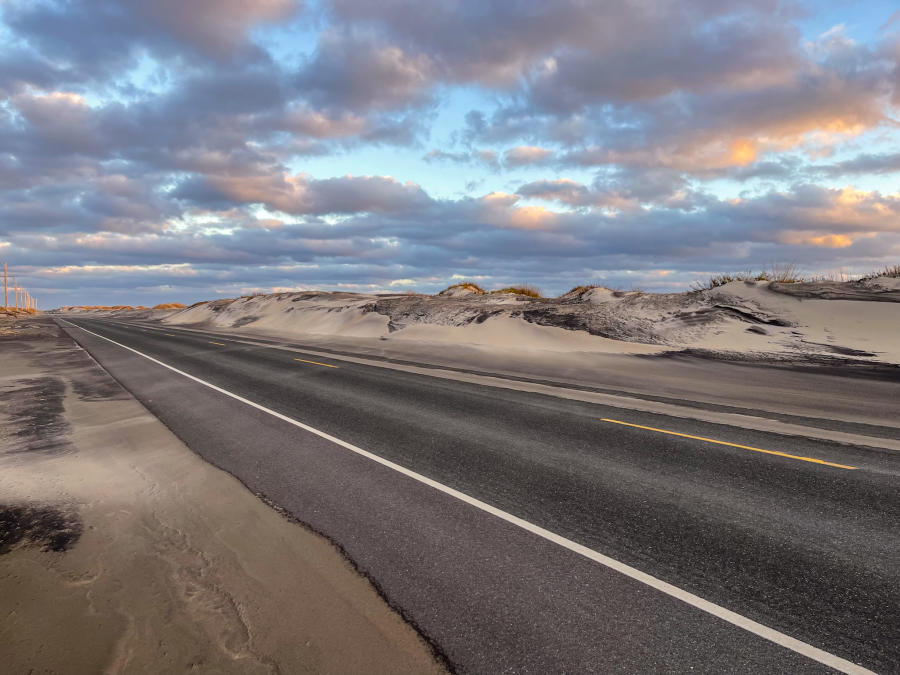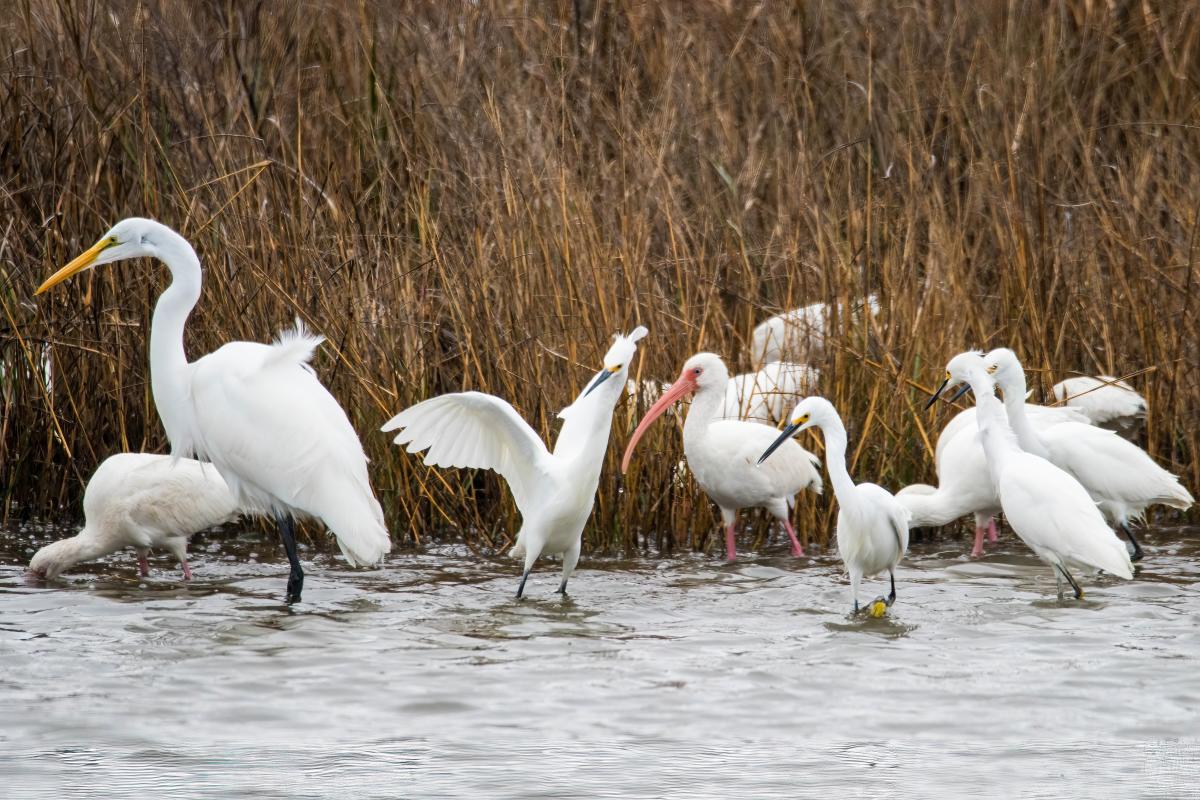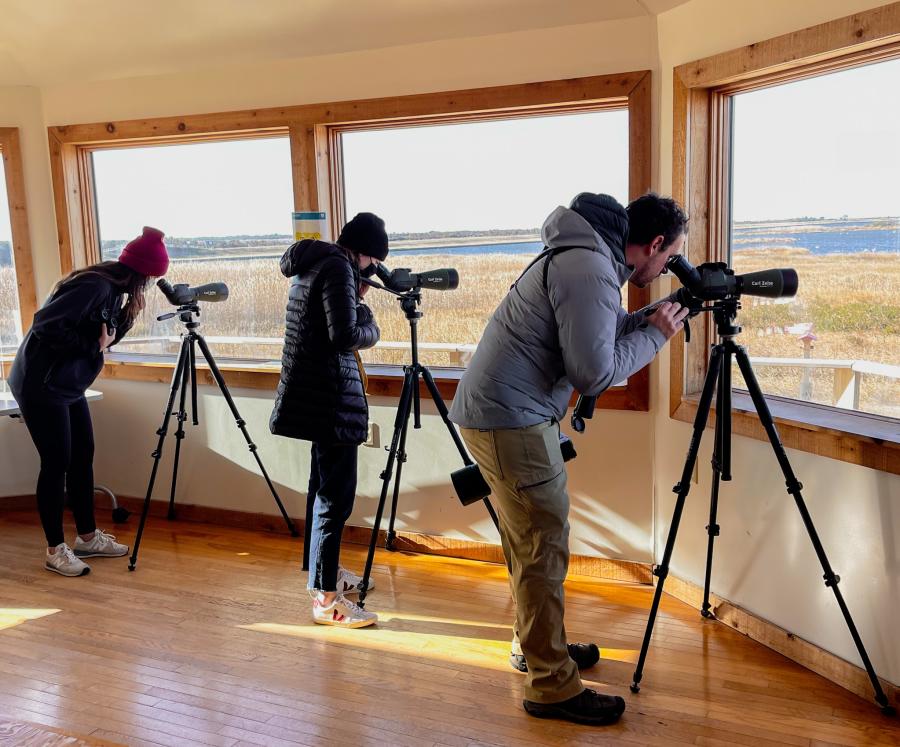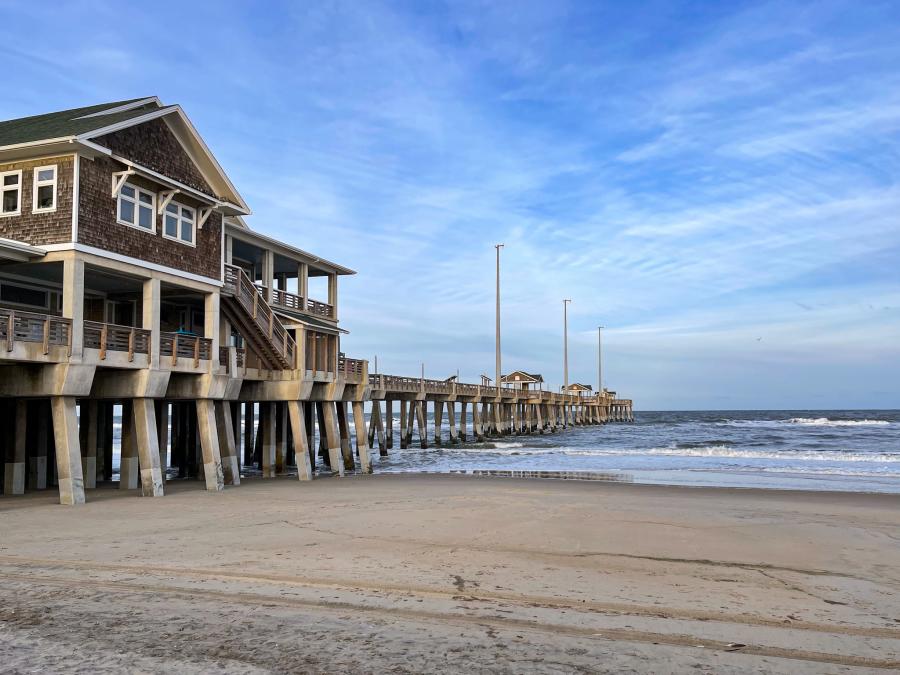The sunrise peeking over the dunes along Route 12 promised a Big Day was ahead on Cape Hatteras National Seashore. Migrating waterfowl and songbirds drew us to this barrier island's natural beauty. The salt marshes, dunes, and maritime forests furnish a winter home for hundreds of bird species. Our exploration started at Pea Island National Wildlife Refuge with our binoculars ready.
Pea Island National Wildlife Refuge

One of Pea Island National Wildlife Refuge's main goals is to provide nesting, resting, and wintering habitat for migratory birds. The refuge boasts wildlife trails, three brackish ponds, observation decks, and photo blinds along the 13-mile strip between the Atlantic Ocean and Pamlico Sound. The North Pond Wildlife Trail is also wheelchair accessible.
We met our guide, Jonathan Cooley from Native Birding Tours, at the Visitor Center and agreed on our plan for the day. We headed south, where the 25,700 acres of water almost jumped out at our car. Diving ducks and Tundra Swans are easily spotted roadside. Our first stop was a pull-over and a gem of a location.
Despite the howling winds, dozens of species were basking in the morning light. We used Jonathan's truck to buffet the gusts while watching snow geese graze on the shore. Northern Pintail, Gadwall, Blue Wing Teal, and Redheads huddled together in the shallow wetlands. Tundra Swans and White Pelicans squawked in the distance. Sand whipped across the road from the dunes creating an otherworldly environment. Note to visitors: wear layers as the Outer Banks is the sixth windiest place in the U.S.
Salt Flats

Located a little further north on the island, the salt marshes and shallow wetlands are a wader's paradise. We spotted White Ibis with their long curved orange beak near the Salt Flats Wildlife Trail. They happily shared the shore with Snowy Egrets and Great Egrets. Meanwhile, Rusty Blackbirds played in the shore grasses. And a group of American Avocets floated nearby.
Vagrants Expected

Our next stop was at the Visitor Center for a walk along the North Pond Wildlife Trail. En route, a Peregrine Falcon eyed a possible meal from trees that rim the pond. Finally, we climbed the observation tower and took in the beauty of this untamed land.
The Visitor Center houses educational wildlife exhibits as well as maps and brochures. Mary, a four-year volunteer, excitedly told about the birds you could observe from the center's scopes. And sure enough, an unexpected Eurasian Widgeon, typically found on the West Coast in winter, floated by with his reddish head and pale pink breast.
Bonner Bridge Pier
The 1,046 foot Bonner Bridge Pier juts into the Oregon Inlet at the northern tip of Pea Island. Located at the end of Basnight Bridge, the pier is an ideal fishing spot and great for marine life and bird watching. Thousands of cormorants flittered on and off the Basnight Bridge pylons. Brown Pelicans darted through the waves. Jonathan noted that ducks would also gather nearby on the small beach.
It's also worth walking through the dunes to the Oregon Inlet Life-Saving Station on the National Register of Historic Places. The station was initially built in 1898 and functioned until 1988. The dune paths show the way to the Atlantic Ocean for shorebird sitings.
Bodie Island Lighthouse

The iconic black and white striped Bodie Island Lighthouse is one of four lighthouses on the Outer Banks. It's scenic in its own right. Even better, the surrounding wetlands and forests also represent another birding opportunity.
A wooden boardwalk weaves its way to an observation platform overlooking a vast marsh. American Black Ducks and Northern Pintail Ducks paddled in the waters below. Tundra Swans floated in the distance.
Winter songbirds gather amongst the pines and underbrush on the lighthouse grounds. After a few pishing calls, Yellow-rumped Warblers darted forward. They graciously paused their berry picking so we could catch a few glimpses.
Warm-Up with Hatteras Clam Chowder
As lunchtime approached, we decided it was time to warm up with a bowl of Hatteras Clam Chowder at the Outer Banks Brewing Station in Kill Devil Hills. This favorite local soup was chock full of minced clams in a hearty vegetable broth. We also sampled several beers brewed onsite.
Head to Blue Water Grill and Raw Bar for fresh seafood served in a lively environment. The restaurant is convenient to Hatteras Island and overlooks Pirates Cove Marina. Don't pass up the opportunity to have fresh fish tacos and the Outer Bank's famously fresh shrimp.
Jennette's Pier

In addition to waterfowl, shorebirds, and songbirds, the Outer Banks is also great for ocean birding. We met Jonathan later in the day at Jennette's Pier. The pier is owned by the North Carolina Aquarium and houses scientific and educational exhibits.
For a nominal fee of $2 per person, you can venture out onto the longest pier in the Outer Banks. We watched the waves roll across the sandbars while keeping an eye open for seabirds. Brown Pelicans, Ring-billed Gulls, and Great Black-backed Gulls rode the ocean breezes. We watched Black Scoters and Northern Gannets rise and fall with the waves. And a couple of Red-throated Loons dove for food in the cold ocean.
Bring Your Checklist
Jonathan shared that birders can find birds located in the Outer Banks that you won’t find inland. Examples Include American Avocets and Least Terns. During the winter bird count in Kitty Hawk, he spotted over 63 species. So whether you hail from North Carolina or elsewhere, you're sure to tick something off your checklist.
The Outer Banks offers experiences for both novice and hard-core birders. The wild beauty is the perfect background to experience the winter migration. In one day, we observed over forty species with over 9,000 birds. The accessibility, great food, and beach vacation environment make this a must-do for every bird lover.


